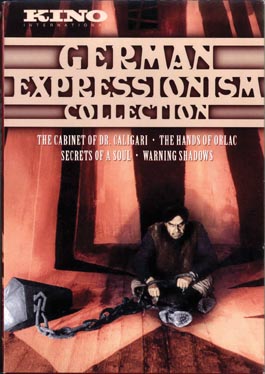home | metro silicon valley index | movies | current reviews | dvd review

German Expressionism Collection
Four discs: Kino Video, $69.95
By Michael S. Gant
In the 1920s, German filmmakers experimented with psychological plots, bizarre sets and weird special effects. This excellent four-disc set serves as an introduction to the movement, known as German Expressionism, which was related to similar advances in painting and theater. Robert Wiene's The Cabinet of Dr. Caligari (1920) is the most famous—and extreme—example. A young man encounters a lurking doctor and his somnambulist henchman, played with stiff joints and penetrating eyes by a young Conrad Veidt. The characters move through angled stage sets painted with spirals and lightning bolts. The surprise ending has been mined by filmmakers ever since. Kino's print retains the strong atmospheric tints of underwater blue, bilious green and sepia. Arthur Robinson's 1923 Warning Shadows is subtitled "A Nocturnal Hallucination." A door-to-door puppeteer puts on shadow plays that foretell outbursts of surrealistic jostling between a husband and wife and a gaggle of visiting suitors. The story (more reverie than plot) proceeds entirely without title cards. Secrets of a Soul, directed in 1926 by G.W. Pabst, attempts to visualize a psychiatric case study about a man who suddenly finds himself overwhelmed with the desire to stab his wife. Supposedly, Freud himself was asked to endorse the project, which was designed to inform the masses about psychoanalysis—he refused. The dream sequences—with looming shadows and superimposed visions of women laughing at the burgher's impotence—still look fresh, even if the man's "cure" is all too pat. The most compelling entry is Wiene's masterful The Hands of Orlac (1924), about a famous pianist (Veidt again) who has the mitts of a murderer grafted to his stumps after a train wreck. In one fearsome moment, the pianist goes to write a note to his beloved, only to see the jagged handwriting of a madman. While not exactly naturalistic, the acting is not nearly as exaggerated as in many silent films. The set contains too many extras—alternate musical scores, scholarly notes, print comparisons and stills galleries—to enumerate, the best of which is a version of Wiene's wacky Genuine: The Tale of a Vampire, from 1920.
Send a letter to the editor about this story.
|
|
|
|
|
|